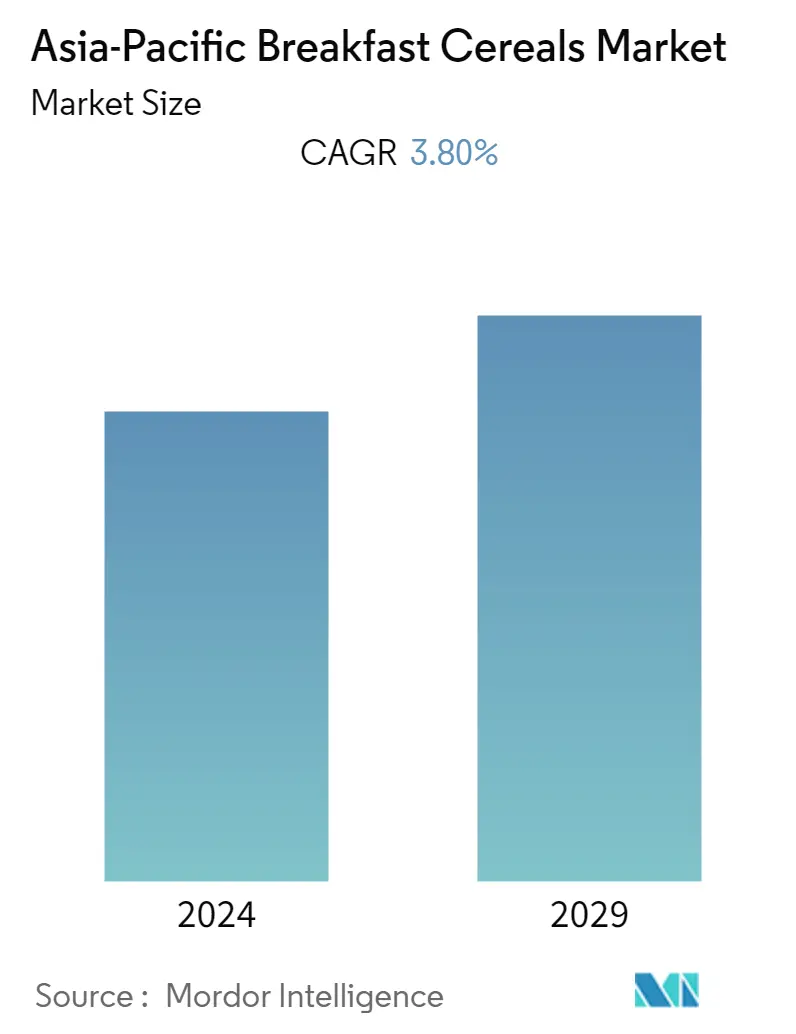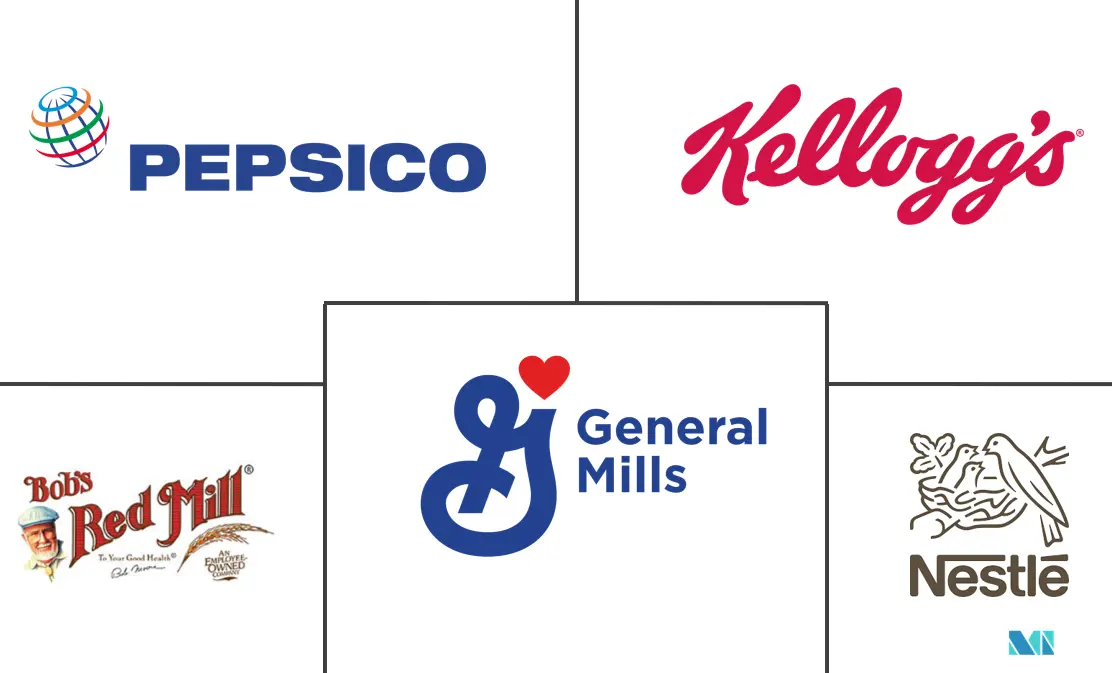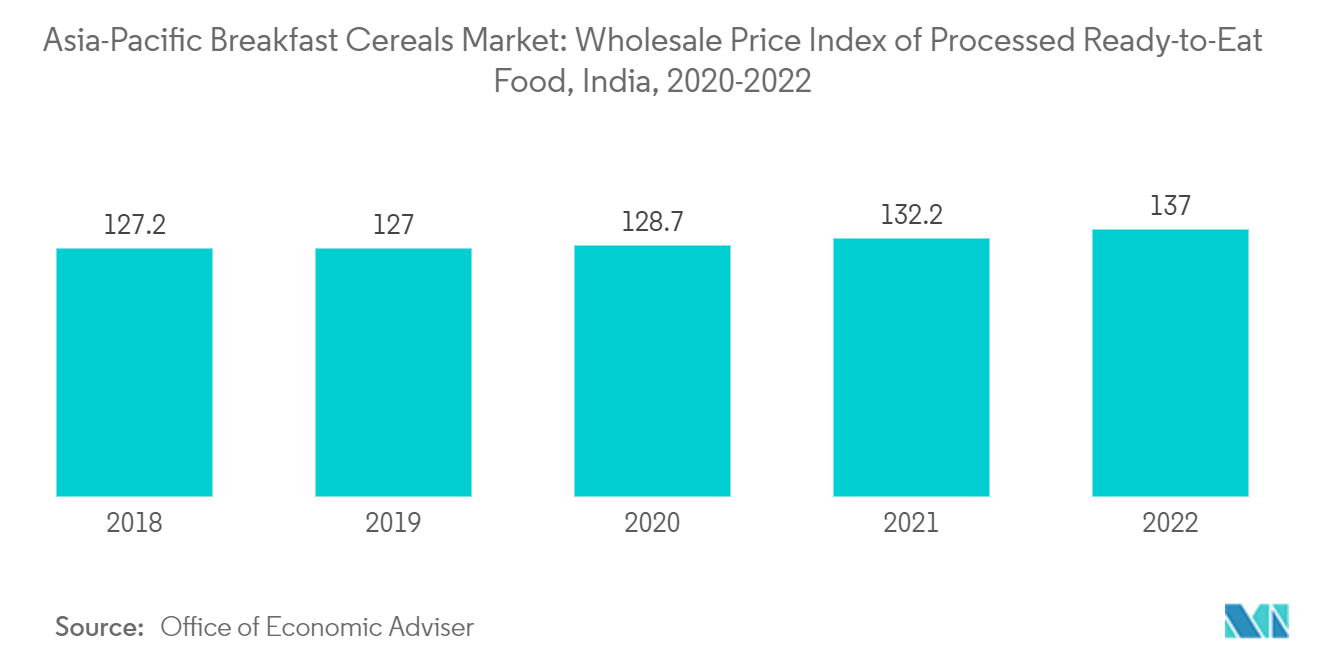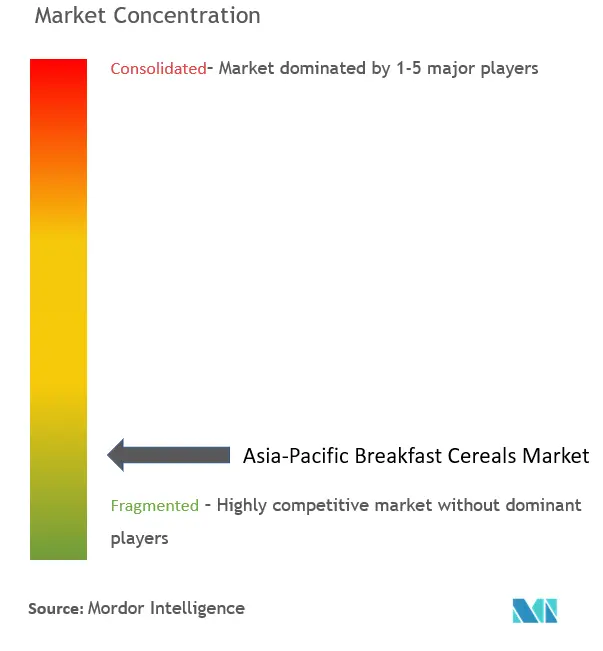APAC Breakfast Cereals Market Size

| Study Period | 2019 - 2029 |
| Base Year For Estimation | 2023 |
| Forecast Data Period | 2024 - 2029 |
| Historical Data Period | 2019 - 2022 |
| CAGR | 3.80 % |
| Market Concentration | Low |
Major Players
*Disclaimer: Major Players sorted in no particular order |
APAC Breakfast Cereals Market Analysis
The Asia-Pacific breakfast cereals market is projected to register a CAGR of 3.8% during the forecast period.
- Breakfast is considered an important meal of the day by many consumers, who prefer convenient, nutritious, and healthy options such as cereals. The Asia-Pacific region's increased spending capacity and growing awareness of nutritional needs are driving the sales of ready-to-eat healthy cereals. The trend for consuming a wholesome breakfast that is easy to prepare and offers numerous benefits is boosting breakfast cereal sales.
- Key players are taking advantage of this trend by offering innovative and healthy cereal options. For instance, PepsiCo's Quaker Oats brand offers ready-to-eat breakfast cereal with 30% reduced sugar content to make them healthier.
- Moreover, millennials and Gen Z consumers are opting for quick breakfast options that fit into their busy schedules and aid their nutritional intake. The growing trend towards consuming processed food products in developing countries of the Asia-Pacific region is further boosting the demand for breakfast cereal.
- The rising number of consumers focused on healthy eating, combined with their willingness to pay a premium price for healthy products, is fueling the market's growth. For example, according to a consumer survey conducted by PepsiCo in December 2021, 90% of urban consumers in India were willing to pay more for healthy alternatives.
APAC Breakfast Cereals Market Trends
Growing Demand for Convenience Food Products
- The Asia-Pacific region is experiencing a growing demand for convenience foods due to changes in social and economic patterns, urbanization, and an increase in purchasing power. As consumers become more health-conscious and seek out new and diverse taste experiences, the sales of breakfast cereals have increased in the region.
- In response to this trend, manufacturers are offering on-the-go options with advanced health claims, such as high in fiber, to appeal to busy consumers, particularly women who are increasingly engaging in work. This has led to rapid growth in the ready-to-cook breakfast cereals market, including products like muesli, granola, and hot cereal, which contains traditionally grown cereal grains such as quinoa.
- Brands are adopting marketing strategies to spread awareness about their breakfast cereal products, including the use of influencer marketing. For instance, Calbee, Inc. used AnyMind Group's influencer marketing platform to increase consumer awareness of its fruit cereal line among Taiwanese consumers. Micro-influencers were used to spread awareness of the "Frugra" fruit cereal.

China Holds the Significant Share
- China is the dominant market for breakfast cereals due to changing consumption patterns and increased interest in healthier options. Chinese consumers prefer ready-to-eat breakfast options such as muesli and granola. The adoption of Western lifestyles and eating habits, along with rising health awareness, is driving the sales of fruit-based and nutritional cereals.
- Market players are developing high-fiber, multigrain, low-carb, and fortified breakfast cereals that appeal to health-conscious consumers. The availability of new and unique flavors, such as durian fruit flavor cereal, is also driving market growth.
- Moreover, nutrition-conscious consumers are seeking a balance between their active lifestyles and nutritious diets. The production of grains such as wheat, oats, rice, and corn in China provides ample raw materials for breakfast cereal production. Additionally, the growing preference for vegan, gluten-free, and sustainable packaging options adds value to the market.

APAC Breakfast Cereals Industry Overview
The Asia-Pacific breakfast cereals market is highly fragmented due to the presence of large international, regional, and domestic players. The major players in the market are General Mills, Inc., Nestlé S.A., The Kellogg Company, Bob's Red Mill, and PepsiCo, Inc., among others. The market is highly competitive due to the increasing rivalry among existing players and emerging players and the adoption of competitive strategies such as mergers, expansions, acquisitions, product innovation, and partnerships for significant market share.
The market players are introducing innovative products to cater to the growing demand for breakfast cereals among consumers for healthy and nutritious cereal products. Product innovation in terms of innovative and new flavors remains the key strategy implemented by the players in the region.
APAC Breakfast Cereals Market Leaders
-
General Mills, Inc.
-
Nestlé S.A.
-
The Kellogg Company
-
Bob's Red Mill
-
PepsiCo, Inc.
*Disclaimer: Major Players sorted in no particular order

APAC Breakfast Cereals Market News
- September 2022: PepsiCo, Inc. brand Quaker Oats launched muesli under its breakfast cereal range in India. The company aimed to expand its product portfolio beyond oats and offer easy-to-make and nutritious packaged food. The product is available in two flavors such as fruit and nut and berries and seeds.
- September 2021: Parle Products, a manufacturer of snack and confectionary products, announced the launch of the breakfast cereal category in India. The company aims to extend its 'Hide & Seek Fills' brand into the breakfast cereal category.
- August 2021: The Kellogg Company launched Fruit Loops under the breakfast cereal category in India. The company aimed to strengthen its position in the cereal category and claimed to offer nutritious and tasty breakfast options for Indian consumers.
APAC Breakfast Cereals Market Report - Table of Contents
1. INTRODUCTION
- 1.1 Study Assumptions & Market Definition
- 1.2 Scope of the Study
2. RESEARCH METHODOLOGY
3. EXECUTIVE SUMMARY
4. MARKET DYNAMICS
- 4.1 Market Drivers
- 4.2 Market Restraints
-
4.3 Porter's Five Forces Analysis
- 4.3.1 Threat of New Entrants
- 4.3.2 Bargaining Power of Buyers/Consumers
- 4.3.3 Bargaining Power of Suppliers
- 4.3.4 Threat of Substitute Products
- 4.3.5 Intensity of Competitive Rivalry
5. MARKET SEGMENTATION
-
5.1 Category
- 5.1.1 Ready-to-cook Cereals
- 5.1.2 Ready-to-eat Cereals
-
5.2 Product Type
- 5.2.1 Corn-based Breakfast Cereals
- 5.2.2 Mixed/Blended Breakfast
- 5.2.3 Other Product Types
-
5.3 Distribution Channel
- 5.3.1 Supermarkets/Hypermarkets
- 5.3.2 Convenience Stores
- 5.3.3 Specialty Stores
- 5.3.4 Online Retail Stores
- 5.3.5 Other Distribution Channels
-
5.4 Country
- 5.4.1 India
- 5.4.2 China
- 5.4.3 Japan
- 5.4.4 Australia
- 5.4.5 Rest of Asia-Pacific
6. COMPETITIVE LANDSCAPE
- 6.1 Most Adopted Strategies
- 6.2 Market Share Analysis
-
6.3 Company Profiles
- 6.3.1 General Mills, Inc.
- 6.3.2 Marico Limited
- 6.3.3 The Kellogg Company
- 6.3.4 PepsiCo, Inc.
- 6.3.5 Bob's Red Mill
- 6.3.6 Post Foods Canada, Inc.
- 6.3.7 Orkla ASA (MTR Foods Pvt Ltd.)
- 6.3.8 GlaxoSmithKline Consumer Healthcare Ltd.
- 6.3.9 Nestlé S.A.
- 6.3.10 Tata Group
- 6.3.11 Parle Products
- *List Not Exhaustive
7. MARKET OPPORTUNITIES AND FUTURE TRENDS
** Subject To AvailablityAPAC Breakfast Cereals Industry Segmentation
Breakfast cereal is a traditional breakfast food made from cereal grains, and usually precooked or ready-to-eat.
The scope of the Asia-Pacific Breakfast cereals market includes segmentation of the market based on category, product type, distribution channel, and geography. By category, the market is segmented into ready-to-cook cereals and ready-to-eat cereals. By product type, the market is segmented into corn-based breakfast cereals, mixed/blended breakfast cereals, and others. By distribution channel, the market is segmented into supermarkets/hypermarkets, convenience stores, specialty stores, online retail stores, and other distribution channels. By geography, the market is segmented into China, Japan, India, Australia, and the Rest of Asia-Pacific.
For each segment, the market sizing and forecasts have been done on the basis of value (in USD million).
| Category | Ready-to-cook Cereals |
| Ready-to-eat Cereals | |
| Product Type | Corn-based Breakfast Cereals |
| Mixed/Blended Breakfast | |
| Other Product Types | |
| Distribution Channel | Supermarkets/Hypermarkets |
| Convenience Stores | |
| Specialty Stores | |
| Online Retail Stores | |
| Other Distribution Channels | |
| Country | India |
| China | |
| Japan | |
| Australia | |
| Rest of Asia-Pacific |
APAC Breakfast Cereals Market Research FAQs
What is the current Asia-Pacific Breakfast Cereals Market size?
The Asia-Pacific Breakfast Cereals Market is projected to register a CAGR of 3.80% during the forecast period (2024-2029)
Who are the key players in Asia-Pacific Breakfast Cereals Market?
General Mills, Inc., Nestlé S.A. , The Kellogg Company, Bob's Red Mill and PepsiCo, Inc. are the major companies operating in the Asia-Pacific Breakfast Cereals Market.
What years does this Asia-Pacific Breakfast Cereals Market cover?
The report covers the Asia-Pacific Breakfast Cereals Market historical market size for years: 2019, 2020, 2021, 2022 and 2023. The report also forecasts the Asia-Pacific Breakfast Cereals Market size for years: 2024, 2025, 2026, 2027, 2028 and 2029.
APAC Breakfast Cereals Industry Report
Statistics for the 2024 APAC Breakfast Cereals market share, size and revenue growth rate, created by Mordor Intelligence™ Industry Reports. APAC Breakfast Cereals analysis includes a market forecast outlook 2029 and historical overview. Get a sample of this industry analysis as a free report PDF download.



